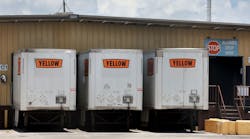The proposed timeline for Yellow Corp. to sell its assets and wind down operations via U.S. Bankruptcy Court is quite ambitious given the scope and scale of the less-than-truckload carrier's operations, a veteran bankruptcy attorney says. Yellow's labor union and constant adversary on Aug. 8 also derided the company's bankruptcy process and called for reform of corporate liquidation laws.
Executives of now-defunct Yellow, the No. 6 for-hire FleetOwner 500 carrier, and their attorneys filed Chapter 11 papers early this week after suspending operations late last month in the wake of failing to push through a restructuring plan, One Yellow, that was backed in the first phase but opposed in later stages by the company's union, the International Brotherhood of Teamsters. CEO Darren Hawkins and his team have laid off almost all of Yellow's 30,000 employees, about 22,000 of whom are union members, and have sketched out a plan to auction Yellow's assets on Oct. 18.
See also: 'Yellow's customers are gone': Inside the LTL giant's bankruptcy filings
Samuel Capuano, a Miami-based partner on the business reorganization team at Berger Singerman LLP who has worked on both sides of numerous bankruptcy cases, told FleetOwner this week that the proposed schedule will be tricky for Yellow to navigate.
"That's very aggressive," Capuano said. "Good luck to them. That's going to be very difficult."
Among the hurdles to clear, Capuano said, is the due diligence prospective buyers will want to do on the company assets they are looking to buy. The third-largest LTL in the U.S. until it shut down, Yellow is looking to sell its fleet, which comprises some 12,700 tractors (about 1,000 of them leased) as well as 42,000 trailers (of which 7,200 are leased), 169 terminals, and six warehouses run by its Yellow Logistics subsidiary, which executives put on the market even before filing bankruptcy papers. Bidders not wanting the whole kit and caboodle will want time to pore over that list to decide what they're willing to buy.
And while it's in just about everyone's interest to move quickly and thus preserve as much value as possible of Yellow's trucks, trailers, and real estate, Capuano said large bankruptcy cases such as Yellow's often produce wrinkles as different creditors assert their rights.
"A million different things can happen in the interim," he said.
Look for the Teamsters to influence a few things: In an Aug. 8 statement that called U.S. business bankruptcy laws "a joke" and called for legislative reforms, Teamsters General President Sean O'Brien pointed out that Teamsters members are Yellow's largest unsecured creditor. O'Brien also noted that Yellow's union workers have agreed to more than $3.7 billion in wage cuts and more than $1.4 billion in pension benefit reductions since 2009 but bemoaned that Chapter 11 allows for the dissolution of contracts and other obligations, many owed to unionized employees.
See also: Yellow files for Chapter 11, blasts union
"Perennially mismanaged companies like Yellow should not be able to find safe harbor from accountability by simply filing for bankruptcy," O'Brien added in the union's statement. "Hard-working people routinely get left behind in this process when they should be at the front of the line to be paid and protected for the sacrifices they make to American employers."
Teamsters General Secretary-Treasurer Fred Zuckerman added: "As in the case of Hostess or what may be the future of Yellow, existing investors or new buyers are allowed to purchase failed companies with the sole intent of restructuring them to kill labor contracts and bust unions. This cannot continue to be the status quo in America, not when workers are being robbed of their wages and retirement because of corporate incompetence. The preservation of jobs and benefits to workers must be the primary objectives of Chapter 11, but they aren't, and it has to change."
The Teamsters have posted a new state-by-state interactive map on their website that points laid-off Yellow employees to job openings with other companies.
Union pension claims could have priority
Capuano said the Teamsters may find a partner in the Pension Benefit Guaranty Corp., the federally chartered entity that helps safeguard and administer benefit plans covering some 33 million people. The PBGC, which has filed notice that it intends to be involved in Yellow's case, could argue that pension claims have priority over others, the attorney said, and thus become a noteworthy player in how auction proceeds are distributed.
Judge Craig Goldblatt scheduled his first Yellow hearing in the U.S. Bankruptcy Court District of Delaware for the afternoon of Aug. 9 to go over a range of standard motions that will enable Yellow to, among other things, access interim funding, continue basic operations, and pay certain bills. Not to be decided at that time after being on the original agenda: Up to $142.5 million in debtor-in-possession financing from Apollo Global Management, which also holds much of Yellow's debt. Yellow executives said in a filing on Aug. 9 they "will discuss the status of interim DIP financing with the Court at the hearing and will request a later hearing" but didn't offer an explanation for the change.
That video-conferenced hearing is to take place hours after Yellow reported its second-quarter financial results, which showed a net loss of $12.3 million on revenues of about $1.1 billion—declines from a profit of $61.5 million and sales of more than $1.4 billion in the same period of 2022. The numbers showed how Yellow's fortunes had already deteriorated this spring: It generated an operating profit of nearly $39 million (compared to $99 million the year prior) thanks only to a $76 million gain on the sale of some property.
Meanwhile, shares of Yellow, which have been on a roller coaster in recent weeks, will be delisted next week because of the company's Chapter 11 filing. Officials with the Nasdaq Stock Market have told the company trading in the stock (Ticker: YELL) will be suspended at the opening of business on Aug. 16. On the morning of Aug. 9, the stock was changing hands at around $2.52, down more than 18% from their previous close.




